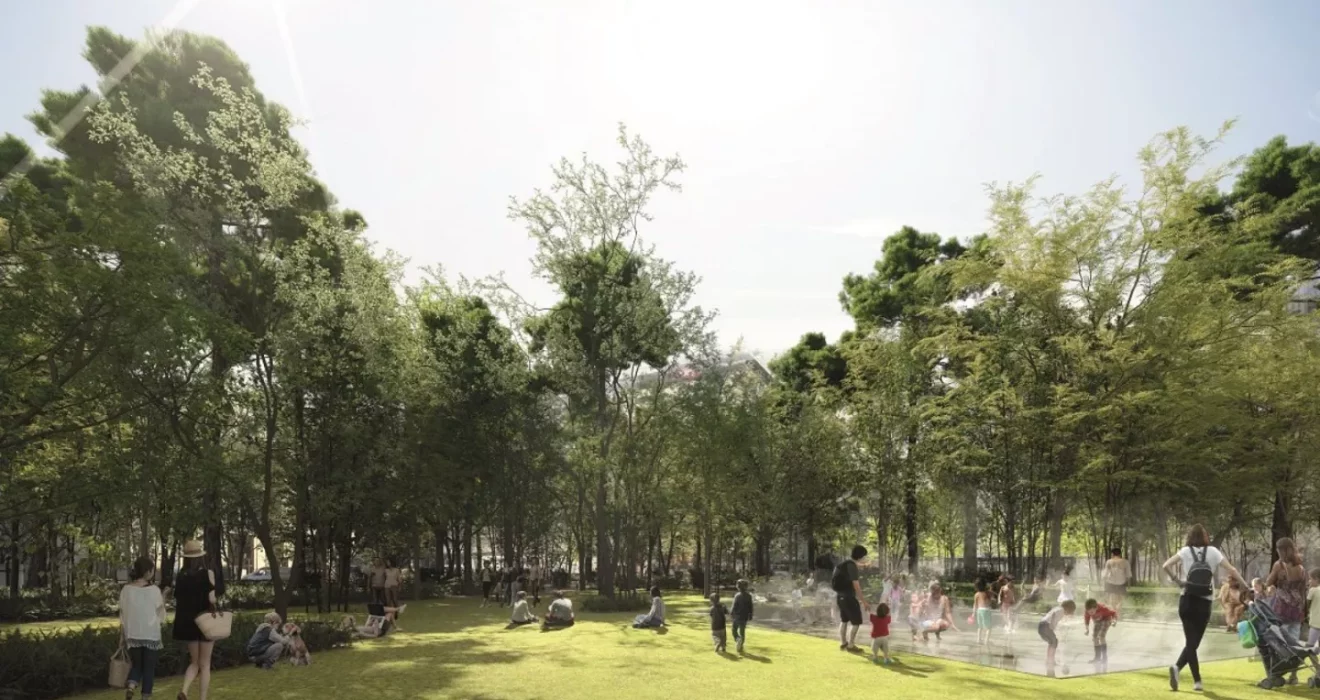In response to the pressing challenges posed by climate change, Paris has revealed an ambitious vision for a greener future by undertaking a transformative initiative at Place de Catalogne. The bustling roundabout is set to evolve into an “urban forest,” a pioneering project designed not only to enrich the city’s green spaces but also to combat the urban heat island effect. This forward-thinking endeavor aligns with Paris’ commitment to broader environmental objectives, including the improvement of air quality and the reduction of emissions. By converting a busy traffic site into an urban oasis, Paris Eco-Transformation sets a precedent for sustainable urban planning, reflecting a dedicated effort to create resilient and eco-friendly spaces amidst the evolving landscape of climate-conscious city living.
Urban Forest at Place de Catalogne
Nestled near the bustling Gare Montparnasse railway station, Place de Catalogne is on the cusp of a remarkable metamorphosis into an urban oasis. This visionary project involves the planting of nearly 500 trees, turning a once congested car traffic site into a vibrant urban green space. The initiative, slated for completion by June 2024, symbolizes a significant shift towards sustainable urban planning and the cultivation of a more bike-friendly environment. Beyond its aesthetic appeal, this transformation aligns with Paris’ broader commitment to combat the urban heat island effect, enhance air quality, and contribute to global emissions reduction. The revitalization of Place de Catalogne exemplifies a strategic endeavor to integrate nature seamlessly into the urban fabric, fostering a harmonious balance between human activity and ecological well-being in the heart of Paris.
Cooling Paris and Reducing Emissions
Mayor Anne Hidalgo champions a comprehensive approach to climate-responsive initiatives through the transformative urban forest project at Place de Catalogne. Stressing its diverse benefits, she underscores that temperatures within this green haven will be four degrees lower than the adjacent areas, effectively mitigating the urban heat island effect. This cooling phenomenon not only fosters a more pleasant urban environment but aligns seamlessly with Paris’ commitment to combat global warming. Beyond the aesthetic and temperature benefits, the project contributes to enhancing air quality and plays a crucial role in the reduction of emissions. By addressing multiple environmental challenges simultaneously, the urban forest at Place de Catalogne stands as a beacon of sustainable urban planning, showcasing Paris’ dedication to creating resilient, eco-friendly spaces for its residents.
Paris’ Commitment to Water Quality
Determined to enhance its environmental legacy, Paris is undertaking a groundbreaking commitment to restore the Seine River to swimmable conditions after a century-long prohibition. City officials have unveiled plans to rejuvenate the waterway, focusing on comprehensive measures to clean up the river and establish innovative outlets for wastewater. These efforts have not only resulted in improved water quality but also heralded the return of 30 to 35 fish species to the Seine. This ambitious initiative showcases Paris’ unwavering dedication to revitalizing its waterways, creating a paradigm shift in how urban ecosystems interact with their natural surroundings. The move towards a swimmable Seine underscores the city’s commitment to fostering a healthier, more sustainable environment for its residents, setting an inspiring precedent for urban water management worldwide.
Mayor Hidalgo’s Climate Vision
Mayor Hidalgo’s visionary statement in 2019, recognizing the pressing need to adapt to shifting temperatures, embodies Paris’ proactive and forward-thinking stance in combating climate change. This acknowledgment of urgency serves as the driving force behind the city’s multifaceted initiatives, ranging from the establishment of urban forests to the creation of extensive cyclable pathways. Paris, under Hidalgo’s leadership, has embraced a holistic approach, recognizing the interconnectedness of environmental, social, and economic factors in building a resilient and sustainable future. These initiatives not only respond to immediate climate challenges but also lay the groundwork for a Paris that thrives in harmony with nature. As the city acts today for tomorrow, Mayor Hidalgo’s climate vision exemplifies the commitment to leaving a lasting positive impact on Parisians and inspiring cities worldwide to adopt comprehensive strategies for a sustainable and resilient future.
Paris on Two Wheels: A Cyclable City by 2026
Parallel to the groundbreaking urban forest initiative at Place de Catalogne, Paris’ Eco-Transformation on an ambitious journey to transform into a fully cyclable city by 2026. The city’s visionary Plan Velo: Act 2 outlines the strategic addition of over 80 miles of bikeable pathways, underscoring a forward-thinking commitment to sustainable transportation. This comprehensive cycling plan is not merely a pragmatic solution to urban mobility but also a testament to Paris’ dedication to a green and eco-friendly urban landscape. The integration of extensive bikeable routes not only promotes healthier and environmentally conscious commuting but also aligns seamlessly with the broader ethos of creating resilient, livable urban spaces that prioritize the well-being of both the city and its inhabitants.
Paris’ Commitment to Urban Greening: Planting 170,000 Trees
The metamorphosis of Place de Catalogne into an urban forest is a pivotal component of Paris’ expansive commitment to urban greening. Beyond this singular endeavor, the city ambitiously plans to plant a total of 170,000 trees between 2020 and 2026, with approximately 63,000 trees already gracing its landscape. Mayor Hidalgo’s visionary initiative, unveiled in 2019, sets the ambitious goal of covering half of Paris with vegetation. This commitment not only exemplifies a dedication to creating green spaces but also aligns with Paris’ broader mission of achieving carbon neutrality by 2050. The strategic planting of trees across the city signifies a proactive approach to combatting climate change, enhancing biodiversity, and fostering a sustainable urban environment that prioritizes the well-being of both its residents and the planet.

